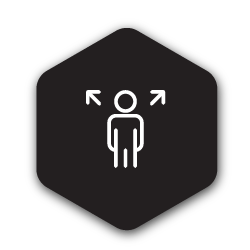The merchandising displays you use in-store can go a long way to helping you achieve your objectives. How? Let's say one of your objectives is to increase your sales. With the right display and the merchandising strategies to match the products on the shelf, you can ensure your customers find the products they want and when they want them.
That leads to an increase in sales as more customers realise that shopping at your store is easy. It could help you achieve another one of your objectives - to improve the overall shopping experience. They’ll find what they need and keep returning. Of course, the converse is also true. Choose the wrong display as well as the wrong strategy or tactic and you can, quite easily, find yourself wasting both your time and money.
About the contributors
Isabel Wessels joined DotActiv in 2017 as a senior space planner, creating data-driven planograms for one of the largest pharmacy retailers in Africa - Dis-Chem. She was promoted to account manager for Dis-Chem’s FMCG department in 2019.
Kyle Fanner joined DotActiv in 2016 as a retail space planner. He has since worked on various accounts before being promoted to an account manager. Today, he looks after various ad-hoc accounts as well as our Scanners team.
Tayla Grifo joined DotActiv in 2016 as a retail space planner. She has worked on various accounts, including Pick n Pay. In 2020, she was promoted to the newly established Software Account Management team where she oversees various software accounts.

Decide on your business objectives
Before you can understand whether or not your chosen merchandising displays are working for or against your business, you'd need to choose your objectives. That much is obvious.
So what do you want to achieve as a retail business? It could be to improve customer loyalty. Alternatively, you may want to improve your store layout. Or maybe it's to have better control of your inventory. Whichever objective/s you do choose, they must fit in with your business' end goal.
After all, increasing profits might be a worthwhile objective for many. But there is more to growing a business than increasing your profits. If you have been around for a while, it might be better to diversify your product range. Likewise, if you’re a small business, you might want to improve your customer service.
Here are two examples. Let’s say that you want to provide products that are competitively priced. Or, you want to differentiate yourself from your competitors. In either case, you’d need to ensure that you set up your merchandising displays in a way that allows you to achieve these goals.
For both, that means choosing the most appropriate merchandising strategy. And when you talk about strategy, another topic is more than likely to come up. That's your category roles. In truth, we've already referred to two - Routine and Seasonal. That's because through your merchandising strategies, you can tie the role of your categories to your objectives.
Suffice to say, once you’ve chosen your objectives, it’s critical to match them to a category role and strategy that will help you achieve them.

Match your objectives to how you merchandise your products
As we noted in this article, aligning internally around the role of your category can help you to understand how your customers behave towards the different categories in your store. This allows you to make smarter category management decisions.
Consider the four major consumer-based category roles - Destination, Routine, Seasonal, and Convenience. Each role has an objective. Some have more than one objective while others can overlap.
Let's say, for example, that one of your objectives is to increase the average spend of your customers in a category. In that case, you could first give the category a Destination, Routine or Convenience role.
Next, you can look at the most appropriate merchandising strategy that would help you achieve this objective.
In this case, it's a Transaction Building strategy. This particular strategy focuses on increasing the size of the average category transaction. As for how you can use this on your merchandising displays, you could display items in a way that encourages impulse purchases.
So, if a shopper comes into your store looking for a particular product, you could cross-merchandise complementary items nearby. Or, place a display at the end of an often trafficked aisle with appropriate signage and include a '3 for 2' deal.
If, on the other hand, you've recently restocked your store with Sunscreen or Skincare items - a typical Seasonal product category - a Transaction Building strategy wouldn't be as effective in helping you to generate profit or increase spend. You would be better off merchandising your products using an Excitement Generating strategy.
With such a strategy, you can create excitement and encourage shoppers to purchase the items while they are in stock. While the goal here is to meet the needs of your customer, it can lead to more sales, which is what you're after.

Analyse your retail data to understand if you've chosen correctly
One of the fundamentals of effective category merchandising strategies is understanding the intent of the strategy that you've chosen. By understanding the intent, you can know what to look for in your retail data. By knowing what to look for, you can understand if you're on the right track to meeting your objectives.
For example, it’s a good idea to identify the measures or key indicators that would best relate to your chosen merchandising strategy. Placement, space, sales, units, and GP are generally good metrics to use but you can use others.
But how would you do this?
Once you’ve identified the measures relative to your strategy, you would gather any data relative to those measures and the SKUs / category in question to build a report that outlines whether or not you have met your pre-defined targets.
For example, if you want to understand whether or not a category that is strategically meant to be a profit generator is delivering as expected, you would need to have the profit data per SKU. You’d also need to understand the space apportionment and placement relative to that strategy. In this case, it would be a matter of GP vs Space and whether or not they have met their targets.
Let’s go into more detail with a different example, and let’s say that you sell Hair Care products. You’ve given the category a Routine role and are following a Transaction Building strategy.
For this example, you could start by analysing your retail data in your macro environment. That’s your department. If we look at the Multicultural category within this department, you could start by evaluating its performance. And then compare it with the entire Hair Care department.
You could evaluate the sales, units and GP contributions of the category within the department. In doing so, you could identify the category performance and the role that it plays within the department.
After the department analysis, you could move to the micro environment of the category. Within the category, you could analyse its performance over a specific period - every 6 months is a good starting point. You can also dive deeper into your category by analysing the performance of the different subcategories and brands.
That said, you mustn’t only analyse your subcategories and brands in isolation. That would be a mistake. You also need to analyse your sales, units and GP growth and performances with one another.
When analysing a category such a Multicultural, it could be a good idea to specifically look at your subcategories by evaluating which products are your best performers? Also, where do you see growth? Which products aren’t selling as well as you’d hoped?
After critically analysing your retail data, you should also consider these factors when merchandising the products on your planogram. This allows you to provide the correct space for the products that deserve it. You can also understand if your chosen strategy is working for your business.

Tweak your merchandising strategy where necessary
If you find that you’re not seeing the desired results, you shouldn’t look to change your objectives. Your objectives, if chosen wisely and appropriately, are not the problem that you need to fix.
Instead, you need to consider: did you choose the right merchandising strategy?
So how often should you tweak your strategy? Unfortunately, there is no straightforward answer. There are multiple factors to consider. It can also ultimately come down to your preference as a retailer.
For example, if you have a Seasonal category like Coffee, you could look at updating the strategy two to four times a year based on your consumer behaviour changes. When testing a strategy, a good period is at least three months because it gives the established strategy enough time to generate results that you can analyse.
Of course, year on year data will give you a holistic view of how your category has performed. If, for example, your goal is to transform the role of a category from Convenience to Destination, it could take time to see results.
In this case, where you’d want to expand your range, you’d need to consider frequently promoting and creating customer awareness about the category as well as the placement of the category in-store and other tactics to ensure shoppers are aware of your intentions.
A year gives shoppers enough time to get used to any promotions, the location of the category as well as the range width. If the category has shown little to no growth or growth in other indicator aspects, it could be time to adapt your strategy and merchandising displays to best fit the purchasing behaviour of your customers.
Conclusion
Looking for a category management solution that caters to your needs? One that can help you to improve your retail business and deliver the results you want?
Interested in finding out more? You can book a custom exploratory consultation here or visit our online store.


